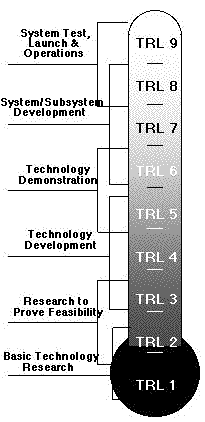
Some of the technologies needed to open
the Lunar Frontier are not yet at
"Technology Readiness Level 1."
Others are somewhat advanced, but in
need of further development.
At whatever stage we find the needed
technologies, our goal is to advance their
readiness level as far upwards as we
can.
|
|
A Major Goal of the University of Luna
Project is to advance the level of
Readiness of Technologies needed to create
an Earth-Moon Economy.
One way to do this, we have
long-termed "Spin-up." This is similar to,
but not exactly the same as NASA's new
Fusion/Spin-in paradigm.
In Spin-up, a
technology that is needed on the Moon
is identified as immature.
- The next step is
to examine that technology for
potentially profitable terrestrial
applications.
- A business plan
is created that allows the
technology to be advanced in pursuit
of those potentially profitable
terrestrial applications
- The goal is to
put an advanced analog of the needed
technology "on the
shelf"
- At the expense
of Consumers, not Taxpayers. While
consumers and taxpayers may largely
overlap, in the one case they are
willing, in the other case they have
no choice.
A non-exclusive starter
list:
- Inexpensive space transportation
systems to lower and minimize the
transportation costs of people,
supplies and capital equipment to the
Moon.
- Earth surface to
Earth orbit
- Earth orbit to
Lunar surface
- Earth orbit to
Lunar orbit
- Lunar orbit to
Lunar surface
- Auxiliary
Landing systems
- Lunar Launch
systems
- Mass
drivers
- Mass
catchers
- Lunar orbit
nodes
- Building
materials that can be made on the
Moon
- Lunar Concrete
(currently the most
mature)
- Glass (optical
quality)
- Glass
fibers
- Glass
fiber/glass matrix
composites
- Ceramics
- Cast
Basalt
- Alloys of the
four engineering metals abundant on
the Moon
- Iron
- Aluminum
- Magnesium
- Titanium
- Modular architecture systems that
use building materials made on the Moon
- Habitat
modules
- activity
modules
- passageway
modules
- pressurized
roadways
- node
connectors
- Home garden
modules
- Quake resistant
connection systems, bulkheads,
sphincters, etc.
- Modular Biospheric systems, with
biosphere contributory systems tailored
for each type of pressurized module
- Graywater
systems to pretreat toilet
wastes
- Living Wall
systems - plants that do not take up
valuable floor space
- Separating
wastes at source with separate
drainage systems
- Home garden
systems
- Power Generation Systems
- Solar
Photovoltaic
- Solar
Concentrator
- Radioisotope
Thermal Generators
- Small nuclear
systems
- Locally produced
fusion fuel based on fast breeder
production of fissionable U-233 from
abundant lunar
Thorium-233
- Fusion Pants
fueled by abundant lunar
Helium-3
- Power Storage Systems - storing
excess dayspan solar for use during
nightspan
- Fuel
Cells
- Potential energy
gravity loops
- Flywheels
- Production of
lunar fuels for
generators
- Dust control systems
- airlocks & airlock
approaches
- space suits
- vehicles and suspensions
- Space Suit Systems
- Improved
Mobility
- Ease of donning
& doffing
- Suits with
turtle backs that dock with the
Habitat, turtle shell back locking
with a compatible concave airlock,
opening together, to allow wearer to
reach in and up to a bar above the
airlock within the habitat so as to
be able to pull him/herself out of
the suit and into the habitat. The
lock would close, the suit disengage
and taken to storage on a dry
cleaning motorized rack type system.
The object is twofold: minimize air
losses through airlock cycling and
minimize import of dust into the
habitat space.
- Light suits for
use in shielded but unpressurized
warehouse and storage
areas
- Buppets: Pods
for individuals with wearer actuated
arms and legs or wheels
- Lunar window
systems employing a
zigzag indirect pathway to allow views
of the outside without exposing oneself
to cosmic rays, as a much more
satisfying visual system than the
highest of high definition view
screens
- Sunshine
access systems and
light tube systems
- Robotic systems linking several
robots that act in team
fashion to explore
challenging areas such as lavatubes,
rubble strewn crater floors,
etc.
- Lunar GPS systems -
Lunar orbits are unstable, making this
a challenge
- and on
and on and on
Please
suggest additions to this
list
|